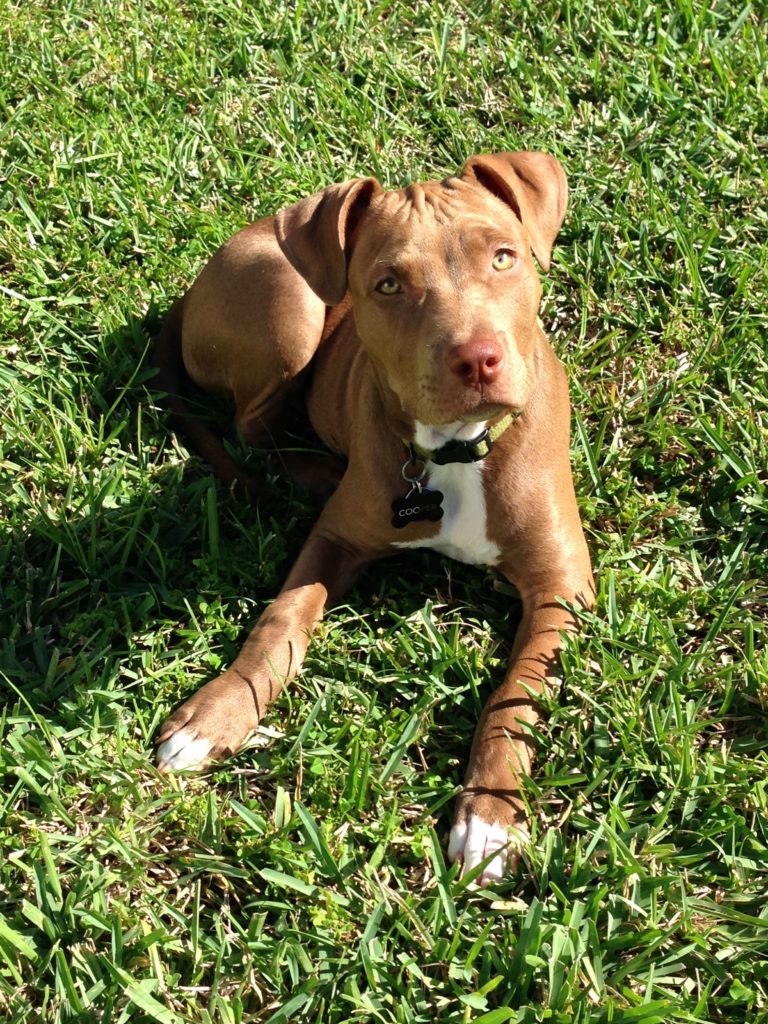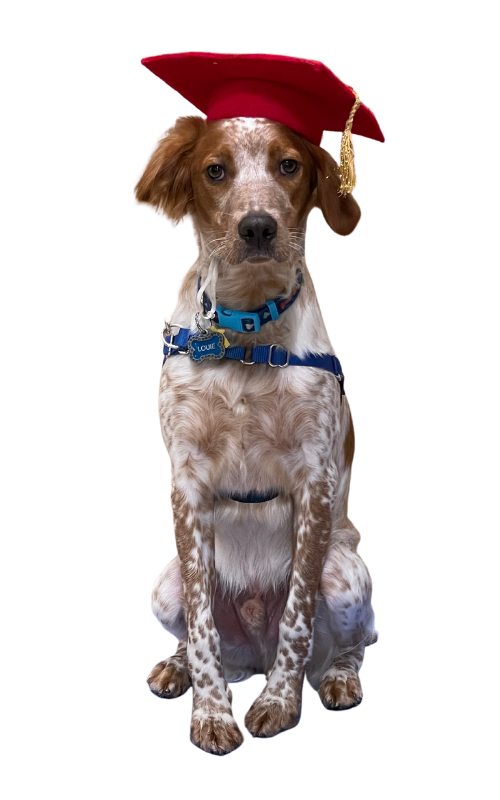Potty training is one of the first goals most new pet owners have. With common sense, consistency and positive reinforcement, potty training can be accomplished successfully.
Accidents shouldn’t be punished. Until your pet is approximately 10 weeks of age, he hasn’t made the connection neurologically between brain and bladder and may not physically be able to hold it, so have patience. Don’t scare your puppy by yelling when you catch him having an accident. You should calmly pick him up and, if he stops going, take him out to his potty area to finish. It’s better to clean a little puddle, than a stream that may be created as your dog runs away from you. You should never scold a puppy or rub his nose in or near his mess when he eliminates inappropriately. Dogs do not have accidents out of spite – they do what works for them. If it’s easier to potty inside on a comfortable rug with good footing in an area that’s perceived as safe, they will do so if given the option. If you create fear around eliminating, you will cause anxiety and your dog will relieve himself in secret behind the couch or when you are out of sight (or worse yet, eat the evidence – YUCK!).
Clean accidents with a pet-rated product formulated for dog odors and stains. If you clean the accidents with ammonia or bleach (or other household detergents), you may be inadvertently luring the dog back to mark over these old spots. These spots now smell like urine and are creating a bigger bullseye, even if they smell lemony clean. Pet-rated cleaners contain enzymes that destroy the residue in urine and feces. Make sure to follow the directions on the bottle exactly and you will be neutralizing the spot, instead of just cleaning/masking the issue. Dogs have an incredible sense of smell and will be encouraged to mark over old spots, even those from months ago. A professional cleaning with pet-rated cleaner may be in order if you’ve been struggling with training for a while.
Take potty breaks often. The more often you take your puppy out to potty appropriately, the more opportunities you give him to be successful with the training process. Take treats with you outside and immediately give him a big “potty party” complete with treats, petting and praise for doing his business successfully! If you wait to give him a treat until he comes back into the house, he will think he’s getting rewarded for returning to the house. You should time the treat to where pup is getting his reward within three seconds of finishing his potty. Be aware, your pup will need to eliminate after four main occasions: upon waking (whether first thing in the morning or after a nap), after drinking, after eating and before/during a play session. Most people miss the play session accidents, as they don’t realize that as they are stimulating the puppy, they are also stimulating the bladder.
Food and water should be provided appropriately. Most puppies are eating three times a day as they have difficulty regulating their blood sugar until they are about 6 months old. Once you put your pup’s food down, you should generally pick it up after 30 minutes. If you allow your pup to graze throughout the day, you will have constant input, constant output, and more difficulty timing bowel movements. If the pup doesn’t eat all the food during his meal, pick it up and add the remainder into his next meal. This way he continues to receive the appropriate amount of food; he just learns that he has 30 minutes in which to eat it. Of course, if you have special instructions from your veterinarian, then that advice supersedes.
Also helpful is feeding a good quality premium food without any corn, wheat, soy, gluten or byproducts. You may spend more, but your pup will eat less and his stools will be smaller. He will potty less often as he’s not passing large stools with a lot of filler and he is absorbing more quality nutrients. Water should be provided after eating, walking, exercising, playing, etc. Urine usually develops 10 to 30 minutes after drinking, feces usually develops more slowly (keep an eye out to learn his transit time – usually 20-60 minutes after eating), so be ready to take him out as soon as possible.
Supervise your puppy. When you can’t have eyes on your puppy, keep him in a pet-proofed, safe area like an exercise play pen, crate or gated area. A laundry room, kitchen or bathrooms are good areas for gating, as they are usually tiled. Or you can keep your puppy with you at all times – tether him to your belt, as this keeps him nearby, out of trouble and promotes you as the leader. He probably follows you everywhere anyway…if you just shut doors to bedrooms, he still has a lot of “real estate” to wander around in and find an inappropriate place to eliminate. If you decide to crate, remember to get a crate big enough for the full-sized dog and buy a divider in order to shrink the floor space. For potty training purposes, the space should be big enough for him to turn around, lie down and stand up in comfortably. Crate training is easy if you begin slowly and feed your dog’s meals in the crate. Remember it’s not jail; it’s his bedroom/den. Crates are very useful as your dog will be confined if he’s at the vet, groomer or travelling. It’s good for him to be comfortable being crated, in general. For potty training purposes, the puppy’s age in months is a guideline for how long he can hold it in the crate: 3 month old puppy can hold it for 2-3 hours, 4 month old can hold for 3-4 hours, and so forth. Dogs generally shouldn’t be crated for much longer than 8 hours total. Of course, a dog sleeping overnight is more likely to hold it longer than these guidelines, as he is less active at night (as we are).
Go outside for short breaks. You can teach your pup to go to potty as soon as he gets outside or on command. Take him out on leash, even if you have a fenced or gated area and take him to his favorite potty spot. Stand still with him (he has 6 foot of leash to wander in every direction) and give him his potty word “Go potty,” “Do your business,” or whatever words you want to use to let him know it’s time to eliminate. Be consistent within your household with the words used. If after five minutes, he doesn’t potty, take him back inside and put him in his confined area for 15 minutes. Take him out again for five minutes and give him the command to potty; keep repeating this process until he eliminates within the first five minutes of going outside. Then throw him his potty party with treats as mentioned earlier; he can also then go for a walk, play off leash, chase the tennis ball, etc. He will learn that he is rewarded with free time, love and treats after he does his business.
Good luck with your new pup. If you are struggling with potty training, or any aspects of training your dog, please reach out to me! I’m Pawsitive I can help!!
Lori Hill, Pawsitive Dog Training, Delray Beach, FL, 561-703-3542


